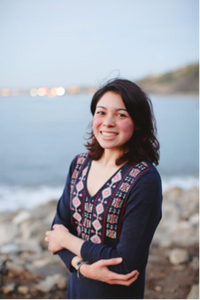Melissa Marquez, 2017 NSF Graduate Research Fellowship Recipient
 Melissa Marquez, a second-year graduate student in Professor Deborah Perlstein’s group, has recently received a 2017 NSF Graduate Research Fellowship. She earned a Bachelor of Science in biochemistry with a minor in mathematics from Mount Saint Mary’s University and as an undergraduate conducted research in Dr. Eric Stemp’s lab focusing on DNA-protein cross-linking resulting from oxidative damage to DNA. She was introduced to Boston by participating in Tufts University’s NSF Research Experience for Undergraduates (REU) program in the summer of 2013 and worked in Dr. Mitch McVey’s lab where she focused on determining the lethality stages in Drosophila melanogaster Werner Syndrome exonuclease mutants. Along with chemistry, Melissa enjoys serving others in their journey toward their science aspirations. She is currently a fellow for the BU NSF GK-12 Global Change Initiative (GLACIER) program where she works at Pierce School in Brookline with a 6th grade science teacher, an officer for BU Women in Chemistry, and a co-leader of the BU Graduate Women in Science and Engineering (GWSE) Girls with Goggles club, an outreach program that provides weekly hands-on activities for middle school girls.
Melissa Marquez, a second-year graduate student in Professor Deborah Perlstein’s group, has recently received a 2017 NSF Graduate Research Fellowship. She earned a Bachelor of Science in biochemistry with a minor in mathematics from Mount Saint Mary’s University and as an undergraduate conducted research in Dr. Eric Stemp’s lab focusing on DNA-protein cross-linking resulting from oxidative damage to DNA. She was introduced to Boston by participating in Tufts University’s NSF Research Experience for Undergraduates (REU) program in the summer of 2013 and worked in Dr. Mitch McVey’s lab where she focused on determining the lethality stages in Drosophila melanogaster Werner Syndrome exonuclease mutants. Along with chemistry, Melissa enjoys serving others in their journey toward their science aspirations. She is currently a fellow for the BU NSF GK-12 Global Change Initiative (GLACIER) program where she works at Pierce School in Brookline with a 6th grade science teacher, an officer for BU Women in Chemistry, and a co-leader of the BU Graduate Women in Science and Engineering (GWSE) Girls with Goggles club, an outreach program that provides weekly hands-on activities for middle school girls.
Through the support of the NSF, Melissa aims to obtain a greater understanding of how iron cofactors are biosynthesized through the cytosolic iron sulfur cluster assembly (CIA) pathway. This system is responsible for iron sulfur (FeS) cluster biogenesis for proteins found outside of the mitochondria in eukaryotic organisms. Essential processes such as DNA replication and repair, transcription, and translation, are all dependent on at least one FeS cluster containing enzyme. A key question is: how are these DNA metabolizing enzymes, also termed targets, recognized by the CIA pathway? Melissa plans to discern the mechanism of CIA target recognition by investigating Cia2, a vital component of the CIA targeting complex known for executing target identification in the last step of the system. Not only is cluster targeting poorly understood for the CIA pathway, but it is not known how any cluster biogenesis pathway identifies its targets. By examining how targets are recognized, this work can provide a model for how target recognition is executed for other cluster biogenesis systems. Melissa is primarily interested in pursuing a career in which she can simultaneously work on innovative experimentations closely related to therapeutic development and reigniting students’ appreciation for deeper learning and, ultimately, love for science.